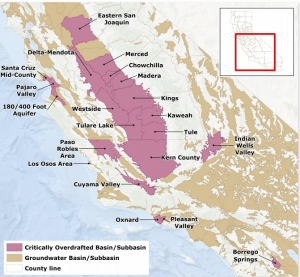A new effort is underway to help solve some of California’s most difficult water supply challenges. The Water Blueprint for the San Joaquin Valley (Blueprint) evolved out of discussions among industry representatives in the San Joaquin Valley that recognize the urgency needed to address surface water reductions, groundwater overdraft, subsidence, and meeting the requirements of the Sustainable Groundwater Management Act (SGMA).
The Blueprint is supported by a broad coalition of industry representatives that are continuing to seek input from all stakeholders including local governments, public water agencies, agricultural industry representatives, disadvantaged communities, environmental organizations, academia, and others.
In 2019, the Blueprint commissioned U.C. Berkeley researchers Dr. David Sunding and Dr. David Roland-Holst to complete an economic impact assessment over the next 20 years if water availability in the San Joaquin Valley is not addressed. The assessment showed that roughly half of the economic impacts and job losses due to water supply shortages in the San Joaquin Valley would occur off of the farm and in many cases would affect businesses outside of the Valley. The impacts, not surprisingly, would be felt first by Valley farms, but will quickly spread to the rest of California.
With up to 1 million acres of productive San Joaquin Valley farmland at risk of being permanently fallowed, the result translates to a farm revenue loss of $7.2 billion per year. That equals one-fifth of Valley farmland and roughly 14% of California’s total farm production.
Furthermore, the assessment anticipates acreage losses within the eight-county San Joaquin Valley, broken down into seven distinct categories: hay and pasture, tree nuts, tree fruits, vines, corn, vegetables, and field crops and grains. The largest projected acreage loss in any single category is in tree nuts, accounting for 327,815 acres, or one-third of the projected 991,870 fallowed acres. The report went on to say that expected fallowing is permanent and would not be recoverable under any expected water supply scenarios.
The assessment calculated that the amount of land fallowing for fruit and vegetables alone would be sufficient to meet the annual food needs of about 7.6 million households.
More concerning, the assessment found that impacts from large scale land fallowing would be regressive, meaning that it would affect a disproportionate number of disadvantaged communities.
Jason Phillips
CEO, Friant Water Authority


